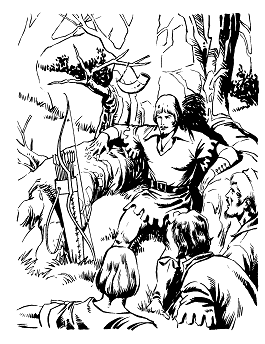Analysis
Joseph Ritson was dismissive of the literary merits of the ballad, writing in 1795 that the work seemed "to have been written by some miserable retainer to the press, merely to eke out the book; being, in fact, a most contemptible performance." [2]
The final two lines of the work seem to segue into Robin Hood and the Valiant Knight (an account of Robin's death), although the "garlands" (collections) of Robin Hood tales that included this generally interposed Robin Hood and the Golden Arrow between this ballad and Valiant Knight. [1] The Forresters Manuscript version of the ballad instead immediately launches into an account similar to that of the 8th fytte of A Gest of Robyn Hode which describes Robin's death at Kerklees (sic) Monastery.
Like many other Robin Hood ballads, the work adopts a rhyme scheme of ABCB that rhymes the second and fourth line of each stanza, also known as a ballad stanza. The melody it was sung to is unknown; the garland versions unhelpfully say "to a Northern Tune".
The historical King Richard really did move around in disguise while passing through Germany on his return from the Crusades, although his attempt to sneak through failed and he was held captive for a ransom. [3]

Robin Hood is a legendary heroic outlaw originally depicted in English folklore and subsequently featured in literature, theatre, and cinema. According to legend, he was a highly skilled archer and swordsman. In some versions of the legend, he is depicted as being of noble birth, and in modern retellings he is sometimes depicted as having fought in the Crusades before returning to England to find his lands taken by the Sheriff. In the oldest known versions, he is instead a member of the yeoman class. Traditionally depicted dressed in Lincoln green, he is said to have stolen from the rich to give to the poor.

Yeoman is a noun originally referring either to one who owns and cultivates land or to the middle ranks of servants in an English royal or noble household. The term was first documented in mid-14th-century England. The 14th century also witnessed the rise of the yeoman longbow archer during the Hundred Years' War, and the yeoman outlaws celebrated in the Robin Hood ballads. Yeomen also joined the English Navy during the Hundred Years' War as seamen and archers. In the early 15th century, yeoman was the rank of chivalry between page and squire. By the late 17th century, yeoman became a rank in the Royal Navy for the common seamen who were in charge of ship's stores, such as foodstuffs, gunpowder, and sails.
Much, the Miller's Son is one of the Merry Men in the tales of Robin Hood. He appears in some of the oldest ballads, A Gest of Robyn Hode and Robin Hood and the Monk, as one of the company.
The Bishop of Hereford is a character in the Robin Hood legend. He is typically portrayed as a wealthy and greedy clergyman who is robbed by Robin and his Merry Men.
Will Scarlet is a prominent member of Robin Hood's Merry Men. He is present in the earliest ballads along with Little John and Much the Miller's Son.

The Merry Adventures of Robin Hood of Great Renown in Nottinghamshire is an 1883 novel by the American illustrator and writer Howard Pyle. Pyle compiled the traditional Robin Hood ballads as a series of episodes of a coherent narrative. For his characters' dialog, Pyle adapted the late Middle English of the ballads into a dialect suitable for children.
Richard at the Lee is a major character in the early medieval ballads of Robin Hood, especially the lengthy ballad A Gest of Robyn Hode, and has reappeared in Robin Hood tales throughout the centuries.
Gilbert Whitehand is a member of Robin Hood's Merry Men about whom next to nothing is known. It is possible that he is a character known from oral literature, with only allusions remaining in written literature.

Robin Hood's Death, also known as Robin Hoode his Death, is an Early Modern English ballad of Robin Hood. It dates from at the latest the 17th century, and possibly originating earlier, making it one of the oldest existing tales of Robin Hood. It is a longer version of the last six stanzas of A Gest of Robyn Hode, suggesting that one of the authors was familiar with the other work and made an expansion or summary of the other, or else both were drawing from a lost common tale. The surviving version in the Percy Folio is fragmentary, with sections missing. A more complete but later version is from the middle of the 18th century, and is written in modern English. Both versions were later published by Francis James Child as Child ballad #120 in his influential collection of popular ballads.
Robin Hood and the Tanner is Child ballad 126. It is a late seventeenth-century English broadside ballad and one of several ballads about the medieval folk hero Robin Hood that form part of the Child ballad collection, which is one of the most comprehensive collections of traditional English ballads but has now been subsumed and surpassed by the Roud Folk Song Index.

Robin Hood and the Potter is a 15th century ballad of Robin Hood. While usually classed with other Robin Hood ballads, it does not appear to have originally been intended to be sung, but rather recited by a minstrel, and thus is closer to a poem. It is one of the very oldest pieces of the surviving Robin Hood legend, with perhaps only Robin Hood and the Monk older than it. It inspired a short play intended for use in May Day games, attested to around 1560. It was later published by Francis James Child as Child ballad #121 in his influential collection of popular ballads in the 1880s.
Robin Hood and the Butcher is a story in the Robin Hood canon which has survived as, among other forms, a late seventeenth-century English broadside ballad, and is one of several ballads about the medieval folk hero that form part of the Child ballad collection, which is one of the most comprehensive collections of traditional English ballads. It may have been derived from the similar Robin Hood and the Potter.
"Robin Hood and the Golden Arrow" is Child ballad 152. It features an archery competition for a golden arrow that has long appeared in Robin Hood tales, but it is the oldest recorded one where Robin's disguise prevents his detection.
Robin Hood and the Valiant Knight is an 18th century ballad of the death of Robin Hood. The song, written in Modern English, was included in the popular "garlands" (collections) of Robin Hood stories and songs published in the 18th and early 19th centuries, generally at the end as a suitable close to the garland. It was later published by Francis James Child as Child ballad #153 in his influential collection of popular ballads.

A Gest of Robyn Hode is one of the earliest surviving texts of the Robin Hood tales. Written in late Middle English poetic verse, it is an early example of an English language ballad, in which the verses are grouped in quatrains with an ABCB rhyme scheme, also known as ballad stanzas. Gest, which means tale or adventure, is a compilation of various Robin Hood tales, arranged as a sequence of adventures involving the yeoman outlaws Robin Hood and Little John, the poor knight Sir Richard at the Lee, the greedy abbot of St Mary's Abbey, the villainous Sheriff of Nottingham, and King Edward of England. The work survives in printed editions from the early 16th century, just some 30 years after the first printing press was brought to England. Its popularity is proven by the fact that portions of more than ten 16th- and 17th-century printed editions have been preserved. While the oldest surviving copies are from the early 16th century, many scholars believe that based on the style of writing, the work likely dates to the 15th century, perhaps even as early as 1400. The story itself is set somewhere from 1272 to 1483, during the reign of a King Edward; this contrasts with later works, which generally placed Robin Hood earlier in 1189–1216, during the reigns of Richard I of England and John, King of England.

Robin Hood and the Monk is a Middle English ballad and one of the oldest surviving ballads of Robin Hood. The earliest surviving document with the work is from around 1450, and it may have been composed even earlier in the 15th century. It is also one of the longest ballads at around 2,700 words. It is considered one of the best of the original ballads of Robin Hood.
Robyn and Gandeleyn is an English ballad. The poem is in Sloane Manuscript 2593, a document of lyrics and carols which dates from around 1450. It was first printed by Joseph Ritson in his 1790 collection Ancient Songs. It was later republished in the second half of the 19th century in an anthology of traditional English and Scottish ballads by Francis James Child known as the Child Ballads, where it is Child Ballad 115. Child also divided the continuous text into seventeen stanzas.

The Merry Men are the group of outlaws who follow Robin Hood in English literature and folklore. The group appears in the earliest ballads about Robin Hood and remains popular in modern adaptations. History The Merry Men are Robin Hood's group who work to rob from the rich and give to the poor. They have antagonized the tyrannical rule of Prince John while King Richard is fighting in the Crusades. This also puts them into conflict with Prince John's minions, Guy of Gisbourne and the Sheriff of Nottingham.
Wentbridge is a small village in the City of Wakefield district of West Yorkshire, England. It lies around 3 miles (5 km) southeast of its nearest town of size, Pontefract, close to the A1 road.

Robin Hood and Little John is Child ballad 125. It is a story in the Robin Hood canon which has survived as, among other forms, a late seventeenth-century English broadside ballad, and is one of several ballads about the medieval folk hero that form part of the Child ballad collection, which is one of the most comprehensive collections of traditional English ballads.









